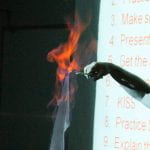This demo can be done with cloth as well.
DESCRIPTION:
When the bill is dipped in the water/alcohol mixture then lit on fire, the water protects the bill from burning. A significant portion of the alcohol is vaporized from the heat causing a large flame around the bill.
C2H5OH + 3O2 → 2CO2 + 3H2O
TOPICS COVERED:
– combustion
– light
– chemical change
– heat capacity
MATERIALS NEEDED:
– 50/50 mixture of ethanol and water
– dollar bill
– tongs
– match
PROCEDURE:
1. dip the dollar bill in the water/ethanol mixture
2. holding the dollar bill with tongs, light on fire
3. the bill will go out on its own, or it can be put by a quick shake (make sure you have a firm grip on it, if you shake it)
ADDITIONAL COMMENTS:
Methanol or isopropyl alcohol mixtures can also be used. NaCl can be added to the mixture to give the flame a yellow color, (other salts could be substituted to bring about different colors, see Colored Flames). Exams could be ‘set ablaze’ before passing them out to students.
SAFETY:
Ethanol is very flammable, therefore caution should be used and goggles worn at all times. Also, the bill should not be lit near the mixture container.
REFERENCES:
Shakhashiri, B.Z. Chemical Demonstrations; University of Wisconsin Press: Madison, 1983; Vol. 1, pp 14.
Jardin, J. et al. Setting Exams on Fire. J. Chem. Ed. 1978, 55, 655.
STORY:
Ask if anyone in the audience has a dollar bill (any denomination) that we could use for a demonstration. Then once they have handed it over we tell them were going to light it on fire but we promise that they will get it back unharmed. Sometimes we joke that if it’s their lunch money, they won’t be eating lunch today. Usually they are hesitant but they don’t say much about it.
